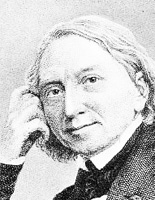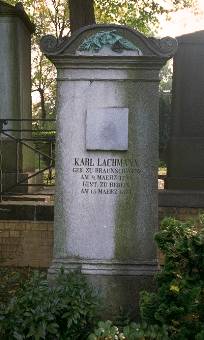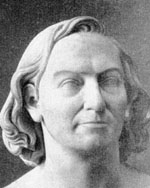Gallery of Philologists
Karl Lachmann
4 Mar 1793 - 13 Mar 1851
Lachmann was born in Brunswick-Lüneburg, and studied at at Leipzig and Göttingen. After a brief period of military service in 1815, he became an assistant master in the Friedrichswerder gymnasium at Berlin, and a Privatdozent at the University. His translation of the first volume of P E Müller's Sagabibliothek des Skandinavischen Altertums appeared in 1816, as did his habilitation essay, Über die ursprungliche Gestalt des Gedichts von der Nibelungen Noth. That same summer he became one of the principal masters in the Friedrichs-Gymnasium of Königsberg, where he assisted his colleague, the Germanist Friedrich Karl Köpke, in preparing an edition of Rudolf von Ems' Barlaam und Josaphat (1818), and in the planning for an edition of the works of Walther von der Vogelweide. In his review of Hagen's Nibelungen and Benecke's Bonerius, contributed in 1817 to the Jenaische Literaturzeitung, he enunciated the rules of textual criticism and elucidated the phonetic and metrical principles of Middle High German in a manner which marked a distinct advance in that branch of investigation.In January 1818 he became professor extraordinarius of classical philology in the University of Königsberg, where he lectured on Old German grammar and the Middle High German poets. For the next seven years he devoted himself to these subjects. Increasing rigor of treatment marked his Auswahl aus den Hochdeutschen Dichtern des Dreizehnten Jahrhunderts (1820). In 1824 he obtained leave of absence to search the libraries of middle and south Germany for further materials.
In 1825 Lachmann became extraordinary professor of classical and German philology at the Humboldt University, Berlin. Why "classical" philology? Already in 1816 he had produced an edition of Propertius; he now followed with a steady stream of further editions: Catullus and Tibullus in 1828, Genesius in 1834, Terentianus Maurus in 1836, Gaius in 1841-1842, Babrius and Avianus both in 1845, the Agrimensores Romani in 1848-1852. Having some time and erudition still to spare, in parallel with these he translated Shapespeare's sonnets in 1820 and the play Macbeth in 1829. In the latter enthusiasm he coincided with the seventeen-year-old Mendelssohn, who wrote his Midsummer Night's Dream Overture in 1826 (the rest of the incidental music for the play would not follow until seventeen years later, for a gala performance in Potsdam in 1843). Walter von der Vogelweide and Shakespeare were equally typical foci of early German Romanticism, and it will surprise no one to learn that Lachmann also carried on an extensive correspondence with the Brothers Grimm, who were only a few years older than himself.
Still further rigor characterized Lachmann's Der Nibelunge Not und die Klage (1826, to be followed by a critical commentary in 1836) and his editions of Hartmann's Iwein (1827) and the previously planned Walther von der Vogelweide (also 1827); an edition of Wolfram von Eschenbach would follow in 1833.
Lachmann, not surprisingly, was promoted to ordinary professor at Berlin 1827, and admitted to the Academy of Sciences in 1830. He was fully established as a brilliant and successful exponent of early German and also of Latin literature, with enough to his credit for three creditable lifetimes.
We now follow him into wider fields.
First we may mention Homer. Lachmann's Betrachtungen über Homer's Iliad, first published in two tantalizing segments (and without capitalization, a style that seems to have been in vogue at the time) in the Abhandlungen of the Berlin Academy in 1837 and 1841, in which he sought to show that the Iliad consists of sixteen independent "layers," or perhaps "lays," variously enlarged and interpolated. This was in part a transfer from his previous Germanic work. The theory is ignored at present, and indeed the "lay" modules which it posited were too long for practical performance, but the Iliadic aristeia module remains as obvious an organizational unit in Homer as it is in the Shwei-hu Jwan.
Both earlier and later than Homer came the Greek New Testament. Here, Lachmann carried to completion Bentley's century-old project for a critical text of the Greek New Testament. The first edition, much reviled by the uncomprehending, appeared in 1831. A 3rd edition, in two volumes, was issued in 1842-1850. In an appendix to this edition, Lachmann listed the points of departure of his text from the received Greek and Latin texts of his own time; they roughly fulfilled Bentley's prediction of how many of them there would be (on the order of 2,000). It was Lachmann's QED in this subject.
Lachmann's New Testament made a decided break with previous tradition in altogether abandoning the standard Greek text of the day (the textus receptus), and attempting to recover de novo, from comparison of manuscripts and from the construction of a tree diagram (stemma) of their relationships, the Greek text of circa 380, which was as far back as Lachmann felt the manuscript evidence could be said to go. This cautious judgement is on the whole still valid today (the papyri must be used to get back to c180, and quite different techniques must be used if we hope to push the subject back another hundred years). Lachmann's manuscript evidence was limited by modern standards, but his Greek text of the Bible is nevertheless recognizable as belonging to the modern type, and it is the first example of that type. It ushers in the modern age of the study of the Biblical texts.
Lachmann's Grave
But If You Seek His Monument, Look BelowLachmann's canon for grouping texts hierarchically was that a common error implies a common origin, a principle which, for all the complications and caveats that must be appended to it in practice, is still rightly regarded as fundamental.His principles for preferring one manuscript reading over another tend to anticipate Streeter's later theory of "local texts." The principles Lachmann used in organizing manuscript readings (following but improving on his predecessors Wolf and Bekker) have been reduced to writing in various ways. Here is one statement:
- 1. Nothing is better attested than that in which all authorities agree.
- 2. The agreement has less weight if part of the authorities are silent or in any way defective.
- 3. The evidence for a reading, when it is that of witnesses of different regions, is greater than that of witnesses of some particular place, differing either from negligence or from set purpose.
- 4. The testimonies are to be regarded as doubtfully balanced when witnesses from widely separated regions stand opposed to others equally wide apart.
- 5. Readings are uncertain which occur habitually in different forms in different regions.
- 6. Readings are of weak authority which are not universally attested in the same region.
In Streeter's terms, Lachmann's New Testament edition aimed at recovering what was later called the Alexandrian text. His manuscript base was insufficient for that task, which was better realized by the 1881 edition of Westcott and Hort.
Separately, Lachmann noted the probability that Mark was the earliest Gospel (not Matthew, which is preferred by the Church, and stands first in the Biblical Canon, and not Luke, which stands first in the hearts of believers generally). He pointed out in particular that the order of material in Mark tends to be duplicated in Matthew and Luke, and that where either Matthew or Luke differ in order from Mark, they also tend to differ from each other, implying divergence from an earlier original sequence which is better preserved in Mark. This argument has been attacked as fallacious by Butler in 1951 and by Farmer in 1968; the attempt has even been made to name this argument the Lachmann Fallacy. The argument is not fallacious. It is rather, all things considered, the account of Synoptic relationships which raises the fewest secondary problems. To paraphrase the general rule for directionality problems, it is the position from which the known state of things can most plausibly be derived. Whether or not the version of Mark involved in this relationship was our canonical mark or (as Lachmann thought) a prior state of that text, is a separate question, and is being separately pursued.
Lachmann's work in Latin, which as we have seen dates from his earliest scholarly activities, continued also to the end, and he spent most of his last years on his final landmark achievement, his Lucretius (1850), called by Munro "a work which will be a landmark for scholars as long as the Latin language continues to be studied." In it, Lachmann was able to specify the archetype from which all other Lucretius manuscripts descended: it had 302 pages, with 26 lines to each page. This reconstruction in turn permitted him to restore some earlier transpositions that had been made in the text. Such things are easy when you know how (the present writer has done something similar for the archetypes of the Shang-jywn Shu and Lu Jya's Syin Yw). The trick is in knowing how. Lachmann knew how. Knowing how enabled him to find his way to the structural heart of the matter before him, if not always all the way out to its fingertips. But something, after all, must in fairness be left for those who come after.
Lachmann's name is secure in the history of philology; indeed, in the center aisle of that history. The venom attracted by some of his conclusions only testifies to their importance. As Wilamowitz-Moellendorff said, at the end of a partly acid epitome, "Still, where would we be without Lachmann?"
Precisely.
Readings
- Martin Hertz. Karl Lachmann, Eine Biographie. 1851; repr Biblio 1972. Includes selected works and a full bibliography
- Albert Leitzmann (ed). Briefwechsel der Brüder Jacob und Wilhelm Grimm mit Karl Lachmann. Biedermann 1927.
- Wilamowitz-Moellendorff. History of Classical Scholarship 1921; tr 1982, 130f
2 Oct 2006 / Contact The Project / Exit to Gallery Index Page



